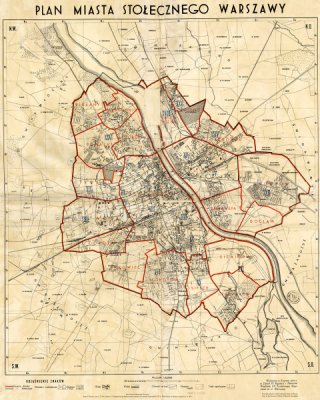
Warsaw in 1933.
Short History of Warsaw Uprising 1944
Poland, the country in Central Europe, with Germany on western border and the USSR on eastern one - in 1939 had 34,849,000 citizens.
The capital of Poland is Warsaw - the town in the middle of the country. In 1939 it had 1,289,000 citizens, that including about 32% of the Jews. The largest Polish river, the Vistula, crosses the town from south to north, dividing the town into two parts. On the right bank of the river Praga (Prague) district is situated. Most of the districts are on the left bank and they include: Wola, Żoliborz, Old Town, Northern and Southern City Centre, Ochota, Mokotów, Powi¶le and Czerniaków.
Before the Second World War Warsaw was often called Paris of the North. It was a beautiful, lively city.
On 1st September 1939 Nazi Germany invaded Poland and by doing so started that what became the Second World War. On 17th September 1939 Poland was attacked from the east by the second aggressor - Soviet Russia. On 27th September 1939, after 3-week-long siege, Germans entered Warsaw. 6-year-long dark period of occupation had started.
As early as in autumn 1939 Nazis started the systematic extermination of Warsaw population, starting with intelligentsia circles. Gestapo carried out numerous arrests of intelligentsia representatives, with the help of lists prepared in advance. The arrested people were put in prisons, sent to concentration camps or murdered in numerous executions, i.e. in Kampinos Forest, in Palmiry. From 1942 they intensify the actions of street arrests, deporting to concentration camps and for slave labour in the Reich, as well as mass executions. Due to those actions the population of Warsaw decreased rapidly.
In October 1940 the major part of the City Centre was marked out and transformed into a walled ghetto, where Jews from Warsaw and transported in from surrounding towns were concentrated. The Jewish population was the subject to merciless extermination. In April 1943 the final annihilation of the ghetto was carried out, which was finished with an uprising in the ghetto which broke out on 18th April 1943 and lasted until 8th of May. Several hundred of Jewish fighters fought uneven, hopeless battle with SS troupes. During the existence of the ghetto 370.000 Polish Jews were either murdered there or transported to concentration camps. After the collapse of Jewish uprising the area of the ghetto was turned into rubble and ashes.
Since the capitulation of Warsaw in September 1939, the underground structures of resistance started to be organised. Poland as a state did not sign an act of capitulation to the Third Reich. The Polish government in exile was formed, Polish army resources were incorporated in the armies of France and Great Britain. Various underground military organizations emerged in the country, which in 1942 were eventually constituted as Armia Krajowa/AK (Home Army). This organization was under the control of Polish government in London. In the meantime in June 1941 Nazi Germany attacked Soviet Russia, which hence became the member of the Allies.
In 1944 the territory of Warsaw and surroundings was divided into seven districts of Home Army, which housed the organised structures of the underground army. In the face of approaching Soviet front, the decision was reached in the headquarters of the Home Army to start an open fight in the capital. There was a double aim: the tying of German forces, which would have allowed the Russians to siege Warsaw and the taking over of the power by the Polish administrative structures, when the Russians would have been entering the territory.
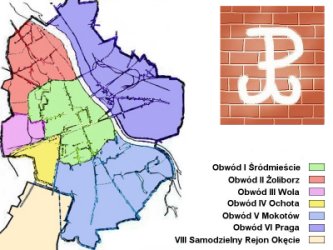
Regions of Home Army in Warsaw
The leaders of the Home Army did not have the full awareness that the future of Poland had been decided during Teheran Conference. During that conference the Allies had decided (without the participation of Polish government) that after achieving of the freedom from Nazi occupation, Polish territory would become a part of Soviet Russia sphere of influence, ruled by Stalin. On Polish lands liberated in the meantime by Russians, Red Army and the forces of NKVD in particular, committed numerous acts of violence towards Home Army - that including the enforced taking over of the weapons and sending the members to the labour camps (lagers).
On 1st of August 1944 at 5 p.m. the Warsaw Uprising broke out. Formally the forces of the insurgents were strong. Some 50 thousand men from Home Army stood for the battle; being organised in battalions and other formations as well as some people from other organisations, including pro-communist People's Army (Armia Ludowa/ AL). Unfortunately the insurgents were very poorly armed. The difficulties to reach the secret weapons' stores resulted in the fact that in the moment of Uprising outbreak the soldiers had access to only 40% of already scarce resources of weapons and ammunition. According to documented sources Polish soldiers could use:
1,000 ordinary guns
300 machine pistols
60 hand-operated machine guns
7 heavy machine guns
35 anti-tank rifles and Piats
1,700 ordinary pistols
25,000 grenades.
The supplies of ammunition were aimed at the a-few-day-long fight. In practice in meant that only 1 of 10 insurgents was armed. The remaining ones had to count on the weapons they either captured from the enemy or taken over from the killed colleagues.
The enemy (about 50,000 German soldiers, gendarmes, policemen as well as Russian and Asian deserters) was vastly better armed. They had tanks, airplanes, armoured trains, artillery, and big quantities of machine weapons..
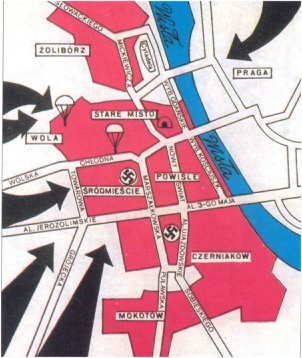
A situation in the first week of the Uprising.
The fight started in a few districts simultaneously brought various results. In the district of Praga, on the right bank of the river, the fight lasted only 3 days. The massive superiority of Germans caused the fact that the insurgents (after a few successes) went back to underground fighting. Some tried to force the Vistula and strengthen the insurgents fighting on the left bank.
From the first days of August heavy fighting was on in the western district of Wola. German troupes reinforced by the tanks pushed the insurgents towards City Centre and Old Town. At the same time the soldiers started the unprecedented massacre of civilians. Within a few days German soldiers with the help of Russian and Asian deserters murdered around 50,000 men, women and children. On 11th of August district Wola surrendered. In the neighbouring district Ochota fights were on in designated points resistance. Very poorly armed insurgents fought the advancing enemy back for almost 2 weeks. On 11th August Ochota district also surrendered. Those fights gave time to insurgents from other districts to prepare the defence.
The centre of fighting was moving towards the east. After the liquidation of the defence in Wola and Ochota districts and taking over the routes to the bridges on the Vistula Germans cut off the Old Town from the City Centre. From 12th August 1944 very heavy fights started to keep this district. Special battalions fought here, who came here from Wola as well as the platoons from the Old Town - thousands of heroic soldiers. Trapped on a small territory, shelled with cannon bullets and bombed from the air they kept their positions day after day. There were attempts of bringing help to the Old Town from the north from Żoliborz and connecting with the City Centre from the south. Unfortunately, these attempts failed.
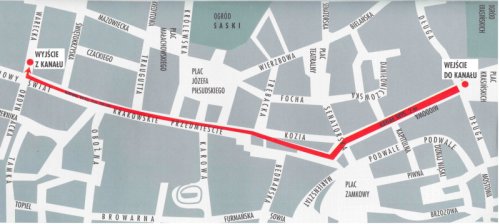
A map of evacuation through the sewers
On 2nd of September the weakened troupes of the Old Town went to City Centre and Żoliborz through the sewers. City Centre received about 1,500 armed men and about unarmed insurgents and forces like nurses. About 800 people managed to evacuate themselves to Żoliborz. Some wounded with the accompanying medical personnel stayed behind in the totally destroyed district. A lot of them were murdered and burned in the insurgents' hospitals when Germans entered the ruins of the Old Town. The wild enemy did not respect any rules of civilised fighting.
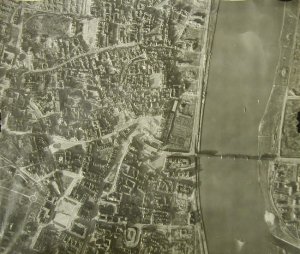
The Old Town during Warsaw Uprising.
After heavy fights on 7th September Germans captured Powisle - the district between Old Town and Czerniaków. Again (like in Wola and Old Town) the wounded lying in hospitals and civilians were murdered. Warsaw power station fell, captured by the insurgents in the first days of August. The town became deprived of electricity.
The following German attack was launched at Czerniaków. Units concentrated in the district at the beginning of the Uprising fought here together with the remains of the units that escaped from the Old Town through the sewers. On 15th September an attempt of landing was carried out from the right bank of the Vistula. The soldiers that took part in that action were those of Polish Army formed in Russia in 1943 and fighting alongside Red Army. Two battalions managed to get to the left bank and fought Germans together with the insurgents. Not being used to street fights the soldiers from the landing died in high numbers. After a few days it became clear that the destiny of Czerniaków is doomed. The remaining insurgents went through the sewers to southern west, to Mokotov, some tried to swim across the river to get to the land liberated by Russians.
When on 23rd the last place of defence fell in Czerniaków, the scenery from previous districts repeated itself. The merciless Nazi soldiers murdered the wounded, raped and shot the nurses. The chaplain of insurgents' troupe who stayed behind with the wounded was hanged on the hook on the wall.
The majority of fights moved then to Mokotov, in the southern part of Warsaw. Heavy fights were on here until 27th of September 1944. Insurgents tried to keep the positions captured at the beginning of the uprising. Steadily retreating to increasingly narrow quarter of streets, the fought back fiercely. In Mokotov Nazis "became famous" for the next murderous act. Despite the fact that under the pressure of the Allies Germany, in the final phase of the uprising, recognised the insurgents as the veterans, on 27th September Nazi gendarmes in Dworkowa Street, in Mokotov murdered about 120 unarmed insurgents, who having lost their way in the sewers, got straight into the hands of their executioners. On 27th September Mokotov surrendered. Some defenders managed to get to City Centre through the sewers, to continua the fighting there.
On 30th September Żoliborz, the northern district of Warsaw (from where the insurgents fought back the advancing Germans successfully from the first days of the uprising), also surrendered.
Only the central part of the town, cut away from the Vistula and encircled from all sides by the enemy, remained in Polish hands. Constant shelling of artillery bullets and aircraft bombs, turned house after house into rubble and ruins. There was no electricity, water and food were scarce. And what was most important the insurgents were missing ammunition.
During the uprising, in August and September, the allies carried out the attempts of help by the air-drops of weapons and ammunition. They were not very successful. Russians did not agree for American bombers to land on their airports, which meant the necessity to return to distant bases in Italy after the air-drops. It additionally increased the loses among the machines and teams taking part in the actions. As the town was divided into sections of defence - the majority of air-drops, dropped on parachutes from high altitude, fell in the areas captured by the enemy.
Taking into account the general situation on 1st October 1944 the Headquarters of Home Army started the talks with Germans about ceasing the fights in Warsaw. On 2nd of October the act of Uprising surrender was signed. The insurgents' troupes on 20th September transformed into regular Warsaw Corpse of Home Army, after giving up the weapons went to captivity. Their number is estimated on about 15,000 people. Some soldiers did not go to captivity, leasing the town with the civilians and attempting to continue conspiracy activity.
Aimed to last for a few days, the Uprising eventually lasted 63 days and became the largest freedom spurt in the history of the Second World War. Despite the massive military advantage, German troupes suffered huge, almost 50% loses: 10,000 killed, 7,000 missing, 9,000 wounded. They were comparing the Uprising to the battle of Stalingrad.
16,000 insurgents and 150,000 civilians were killed in the uprising. Thousands of people were transported to the transit camp in Pruszków and from there 150,000 as slave labour to the Reich and 50,000 to the concentration camps. .
St. Aleksander church (Trzech Krzyzy Square)
 before II World War |
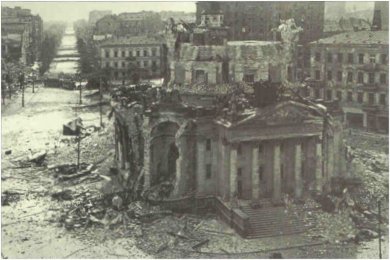 after Warsaw Uprising |
After the fall of the Uprising due the personal order of Hitler the deserted town was for 3 months looted as well as systematically robbed and burned house after house by Germans. In the districts were the Uprising had been fought, some 85% of the buildings were destroyed.
On 17th January 1945 the troupes of Red Army and Peoples' Polish Army entered dead Warsaw through the frozen Vistula.
To fully understand the reasons for the outbreak of Warsaw Uprising and the degree of determination of its Warsaw citizens fighting for their freedom, one has to realise the extent of oppression to which Warsaw had been exposed in the years of the occupation.
The combined loses of citizens of Warsaw in years 1939-1944 account for 850 thousand people - about 170 thousand of which died in the uprising. The remaining victims were the result of systematic and merciless process of extermination of Warsaw population, that lasted through the whole period of Nazi occupation.
To compare - the combined loses for France in the Second World War (soldiers and civilians) stand for about 810,000 people and in Great Britain for about 388,000 people.
The combined loses of Poland in the Second World War (soldiers and civilians) stand for about 6 million 850 thousand people.
Edited by Maciej Janaszek-Seydlitz,
Translated by Zofia Kozłowska-Sobczyk
Copyright © 2005 Maciej Janaszek-Seydlitz. All rights reserved.